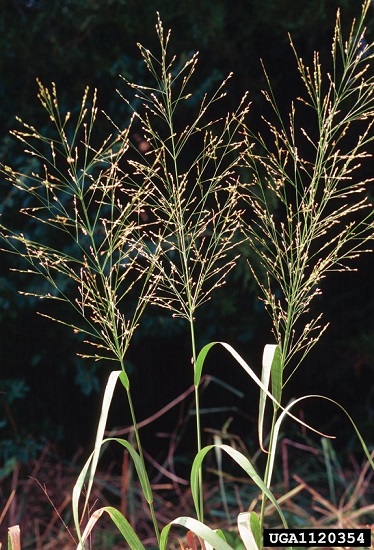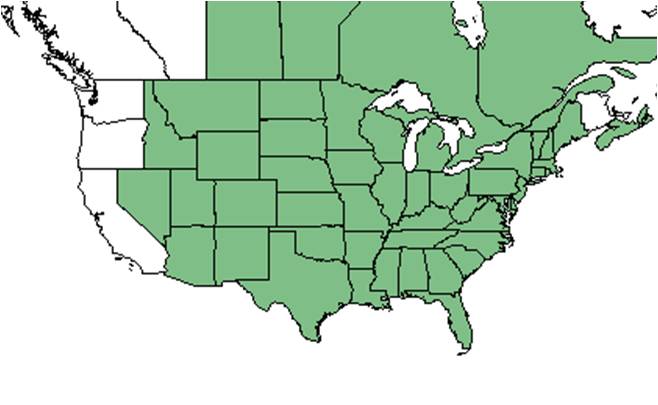Difference between revisions of "Panicum virgatum"
Juliec4335 (talk | contribs) (→Habitat) |
Emmazeitler (talk | contribs) |
||
| Line 18: | Line 18: | ||
}} | }} | ||
| − | Common names: Switchgrass | + | Common names: Switchgrass<ref name="weakley">Weakley, A.S. 2015. Flora of the southern and mid-atlantic states. Working Draft of 21 May 2015. University of North Carolina at Chapel Hill, Chapel Hill, North Carolina.</ref>, Blunt panic grass, Tufted switchgrass |
<!-- Basic life history facts such as annual/perrenial, monoecious/dioecious, root morphology, seed type, etc. --> | <!-- Basic life history facts such as annual/perrenial, monoecious/dioecious, root morphology, seed type, etc. --> | ||
==Taxonomic notes== | ==Taxonomic notes== | ||
| − | + | Synonyms: none.<ref name="weakley">Weakley, A.S. 2015. Flora of the southern and mid-atlantic states. Working Draft of 21 May 2015. University of North Carolina at Chapel Hill, Chapel Hill, North Carolina.</ref> | |
| − | Varieties: ''Panicum virgatum'' Linnaeus var. ''cubense'' Grisebach; ''Panicum virgatum'' Linnaeus var. ''spissum'' Linder | + | Varieties: ''Panicum virgatum'' Linnaeus var. ''cubense'' Grisebach; ''Panicum virgatum'' Linnaeus var. ''spissum'' Linder; ''Panicum virgatum'' Linnaeus ''var. virgatum''.<ref name="weakley">Weakley, A.S. 2015. Flora of the southern and mid-atlantic states. Working Draft of 21 May 2015. University of North Carolina at Chapel Hill, Chapel Hill, North Carolina.</ref> |
==Description== | ==Description== | ||
| − | "Spikelets usually in panicles, round or nearly so in cross section, 2-flowered, terminal fertile, basal sterile, neutral or staminate. First glume usually present, 2nd glume and sterile lemma similar; fertile lemma and palea indurate without hyaline margins. Taxonomically our most difficult and least understood genus of grasses, more than 100 species and varieties are ascribed to the Carolinas by some authors. Note general descriptions for species groups (e.g., 1-4, 5-8, 9-13, and 26-62)." <ref name="Radford et al 1964">Radford, Albert E., Harry E. Ahles, and C. Ritchie Bell. Manual of the Vascular Flora of the Carolinas. 1964, 1968. The University of North Carolina Press. 145. Print.</ref> | + | "Spikelets usually in panicles, round or nearly so in cross section, 2-flowered, terminal fertile, basal sterile, neutral or staminate. First glume usually present, 2nd glume and sterile lemma similar; fertile lemma and palea indurate without hyaline margins. Taxonomically our most difficult and least understood genus of grasses, more than 100 species and varieties are ascribed to the Carolinas by some authors. Note general descriptions for species groups (e.g., 1-4, 5-8, 9-13, and 26-62)."<ref name="Radford et al 1964">Radford, Albert E., Harry E. Ahles, and C. Ritchie Bell. Manual of the Vascular Flora of the Carolinas. 1964, 1968. The University of North Carolina Press. 145. Print.</ref> |
| − | "Elongate, rhizomatous perennial; culms 5-15 dm tall. Blades to 5 dm long, 1.5-8 mm wide, sparsely pilose above basally; sheaths occasionally pubescent, margins occasionally densely ciliate; ligules ciliate or lacerate, 1.5 mm long. Panicle open, 12-50 cm long, 6-20 cm broad. Spikelets 2.8-4.2 mm long. Frist glume 5-9 nerved, acute to keeled-cuspidate, 1.4-3.0 mm long, 2nd glume and sterile lemma 7-9 nerved, acute to cuspidate, 2.8-4.2 mm long, sterile palea2-2.6 mm long; fertile lemma 2-2.6 mm long. Grain grayish, 1-2 mm long." <ref name="Radford et al 1964"/> | + | "Elongate, rhizomatous perennial; culms 5-15 dm tall. Blades to 5 dm long, 1.5-8 mm wide, sparsely pilose above basally; sheaths occasionally pubescent, margins occasionally densely ciliate; ligules ciliate or lacerate, 1.5 mm long. Panicle open, 12-50 cm long, 6-20 cm broad. Spikelets 2.8-4.2 mm long. Frist glume 5-9 nerved, acute to keeled-cuspidate, 1.4-3.0 mm long, 2nd glume and sterile lemma 7-9 nerved, acute to cuspidate, 2.8-4.2 mm long, sterile palea2-2.6 mm long; fertile lemma 2-2.6 mm long. Grain grayish, 1-2 mm long."<ref name="Radford et al 1964"/> |
| + | |||
| + | The spikelets of var. ''cubense'' are 2.8-3.5 mm long, and the first glume (blunt-) acute, ½-⅔× as long as the spikelet. The beak of the sterile lemma exceeds the fertile lemma by 0.2-0.5 mm. Adversely, the spikelets of the other varieties are 3.2-5 mm long, where the first glume is acuminate, ⅗-¾x as long as the spikelet. The beak of sterile lemma exceeding fertile lemma by 0.6-1.3 mm. Var. ''spissum'' can be distinguished by its short, densely-interlocking rhizomes and subascending, basal culms. It also grows densely clumped. Var. ''virgatum'' the rhizomes are elongate, the culms are horizontally divergent, and it grows loosley-clumped.<ref name="weakley">Weakley, A.S. 2015. Flora of the southern and mid-atlantic states. Working Draft of 21 May 2015. University of North Carolina at Chapel Hill, Chapel Hill, North Carolina.</ref> | ||
==Distribution== | ==Distribution== | ||
| + | Var. ''cubense'' is found in the Coastal Plain from Massachusetts to Florida, and west to Missouri and Michigan. It also grows in the West Indies. Var. ''spissum'' grows from East Canada to Pennsylvania, Maryland, and Deleware. Var. ''virgatum'' has the broadest range, from southwest Quebec to Florida and Texas, then west to Nevada. Its range also extends to Bermuda, Central America, and South America.<ref name="weakley">Weakley, A.S. 2015. Flora of the southern and mid-atlantic states. Working Draft of 21 May 2015. University of North Carolina at Chapel Hill, Chapel Hill, North Carolina.</ref> | ||
==Ecology== | ==Ecology== | ||
| − | ===Habitat=== | + | ===Habitat===<!--Natural communities, human-disturbed habitats, topography, hydrology, soils, light, fire regime requirements for removal of competition, etc.--> |
| − | '' | + | Var. ''cubense'' frequents wet to dry sandy pinelands. Var. ''spissum'' grows in gravelly or sandy fresh to brackish shores and swamps. Var. virgatum is found in dry or wet sandy soils of pinelands, fresh and brackish marshes, and shores.<ref name="weakley">Weakley, A.S. 2015. Flora of the southern and mid-atlantic states. Working Draft of 21 May 2015. University of North Carolina at Chapel Hill, Chapel Hill, North Carolina.</ref> This variety Is also frequent and abundant in the Calcareous Savannas and Upper Panhandle Savannas community types as described in Carr et al. (2010).<ref>Carr, S.C., K.M. Robertson, and R.K. Peet. 2010. A vegetation classification of fire-dependent pinelands of Florida. Castanea 75:153-189.</ref> |
| − | |||
| − | + | The species responds negatively to soil disturbance by agriculture in Southwest Georgia.<ref>Kirkman, L.K., K.L. Coffey, R.J. Mitchell, and E.B. Moser. Ground Cover Recovery Patterns and Life-History Traits: Implications for Restoration Obstacles and Opportunities in a Species-Rich Savanna. (2004). Journal of Ecology 92(3):409-421.</ref> | |
===Phenology=== <!--Timing off flowering, fruiting, seed dispersal, and environmental triggers. Cite PanFlora website if appropriate: http://www.gilnelson.com/PanFlora/ --> | ===Phenology=== <!--Timing off flowering, fruiting, seed dispersal, and environmental triggers. Cite PanFlora website if appropriate: http://www.gilnelson.com/PanFlora/ --> | ||
| − | ''P. virgatum'' | + | ''P. virgatum'' flowers from Jun through October.<ref name="weakley">Weakley, A.S. 2015. Flora of the southern and mid-atlantic states. Working Draft of 21 May 2015. University of North Carolina at Chapel Hill, Chapel Hill, North Carolina.</ref> |
| − | |||
===Seed dispersal=== | ===Seed dispersal=== | ||
| − | This species is thought to be dispersed by gravity. <ref>Kirkman, L. Katherine. Unpublished database of seed dispersal mode of plants found in Coastal Plain longleaf pine-grasslands of the Jones Ecological Research Center, Georgia.</ref> | + | This species is thought to be dispersed by gravity.<ref>Kirkman, L. Katherine. Unpublished database of seed dispersal mode of plants found in Coastal Plain longleaf pine-grasslands of the Jones Ecological Research Center, Georgia.</ref> |
<!--===Seed bank and germination===--> | <!--===Seed bank and germination===--> | ||
<!--===Fire ecology===--> <!--Fire tolerance, fire dependence, adaptive fire responses--> | <!--===Fire ecology===--> <!--Fire tolerance, fire dependence, adaptive fire responses--> | ||
Revision as of 16:12, 2 October 2020
| Panicum virgatum | |
|---|---|

| |
| Photo by James H. Miller & Ted Bodner, Southern Weed Science Society, Bugwood.org | |
| Scientific classification | |
| Kingdom: | Plantae |
| Division: | Tracheophyta- Vascular plants |
| Class: | Lilianae - Monocotyledons |
| Order: | Poales |
| Family: | Poaceae |
| Genus: | Panicum |
| Species: | P. virgatum |
| Binomial name | |
| Panicum virgatum L. | |

| |
| Natural range of Panicum virgatum from USDA NRCS Plants Database. | |
Common names: Switchgrass[1], Blunt panic grass, Tufted switchgrass
Contents
Taxonomic notes
Synonyms: none.[1]
Varieties: Panicum virgatum Linnaeus var. cubense Grisebach; Panicum virgatum Linnaeus var. spissum Linder; Panicum virgatum Linnaeus var. virgatum.[1]
Description
"Spikelets usually in panicles, round or nearly so in cross section, 2-flowered, terminal fertile, basal sterile, neutral or staminate. First glume usually present, 2nd glume and sterile lemma similar; fertile lemma and palea indurate without hyaline margins. Taxonomically our most difficult and least understood genus of grasses, more than 100 species and varieties are ascribed to the Carolinas by some authors. Note general descriptions for species groups (e.g., 1-4, 5-8, 9-13, and 26-62)."[2]
"Elongate, rhizomatous perennial; culms 5-15 dm tall. Blades to 5 dm long, 1.5-8 mm wide, sparsely pilose above basally; sheaths occasionally pubescent, margins occasionally densely ciliate; ligules ciliate or lacerate, 1.5 mm long. Panicle open, 12-50 cm long, 6-20 cm broad. Spikelets 2.8-4.2 mm long. Frist glume 5-9 nerved, acute to keeled-cuspidate, 1.4-3.0 mm long, 2nd glume and sterile lemma 7-9 nerved, acute to cuspidate, 2.8-4.2 mm long, sterile palea2-2.6 mm long; fertile lemma 2-2.6 mm long. Grain grayish, 1-2 mm long."[2]
The spikelets of var. cubense are 2.8-3.5 mm long, and the first glume (blunt-) acute, ½-⅔× as long as the spikelet. The beak of the sterile lemma exceeds the fertile lemma by 0.2-0.5 mm. Adversely, the spikelets of the other varieties are 3.2-5 mm long, where the first glume is acuminate, ⅗-¾x as long as the spikelet. The beak of sterile lemma exceeding fertile lemma by 0.6-1.3 mm. Var. spissum can be distinguished by its short, densely-interlocking rhizomes and subascending, basal culms. It also grows densely clumped. Var. virgatum the rhizomes are elongate, the culms are horizontally divergent, and it grows loosley-clumped.[1]
Distribution
Var. cubense is found in the Coastal Plain from Massachusetts to Florida, and west to Missouri and Michigan. It also grows in the West Indies. Var. spissum grows from East Canada to Pennsylvania, Maryland, and Deleware. Var. virgatum has the broadest range, from southwest Quebec to Florida and Texas, then west to Nevada. Its range also extends to Bermuda, Central America, and South America.[1]
Ecology
Habitat
Var. cubense frequents wet to dry sandy pinelands. Var. spissum grows in gravelly or sandy fresh to brackish shores and swamps. Var. virgatum is found in dry or wet sandy soils of pinelands, fresh and brackish marshes, and shores.[1] This variety Is also frequent and abundant in the Calcareous Savannas and Upper Panhandle Savannas community types as described in Carr et al. (2010).[3]
The species responds negatively to soil disturbance by agriculture in Southwest Georgia.[4]
Phenology
P. virgatum flowers from Jun through October.[1]
Seed dispersal
This species is thought to be dispersed by gravity.[5]
Conservation and management
Cultivation and restoration
Photo Gallery
References and notes
- ↑ 1.0 1.1 1.2 1.3 1.4 1.5 1.6 Weakley, A.S. 2015. Flora of the southern and mid-atlantic states. Working Draft of 21 May 2015. University of North Carolina at Chapel Hill, Chapel Hill, North Carolina.
- ↑ 2.0 2.1 Radford, Albert E., Harry E. Ahles, and C. Ritchie Bell. Manual of the Vascular Flora of the Carolinas. 1964, 1968. The University of North Carolina Press. 145. Print.
- ↑ Carr, S.C., K.M. Robertson, and R.K. Peet. 2010. A vegetation classification of fire-dependent pinelands of Florida. Castanea 75:153-189.
- ↑ Kirkman, L.K., K.L. Coffey, R.J. Mitchell, and E.B. Moser. Ground Cover Recovery Patterns and Life-History Traits: Implications for Restoration Obstacles and Opportunities in a Species-Rich Savanna. (2004). Journal of Ecology 92(3):409-421.
- ↑ Kirkman, L. Katherine. Unpublished database of seed dispersal mode of plants found in Coastal Plain longleaf pine-grasslands of the Jones Ecological Research Center, Georgia.